Soldering Guitar Pickups, Circuit Wiring, and Parts
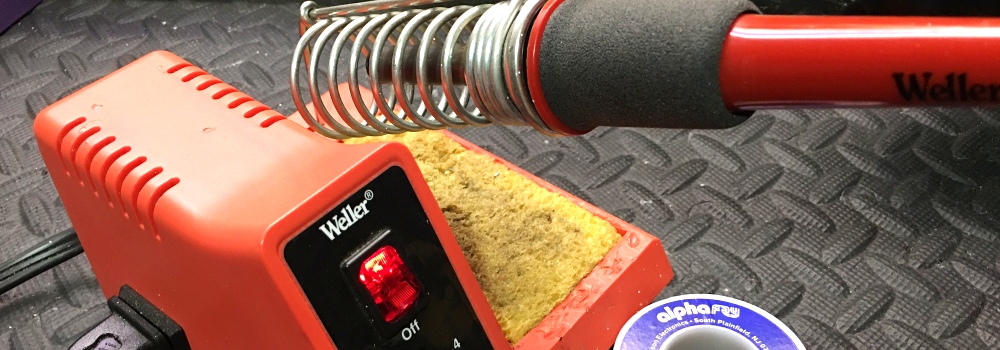
Soldering is an essential skill for building and repairing guitar circuit wiring. Learn about guitar soldering including soldering station kits, tools, and how to solder guitar pickups and parts.
What is Soldering
Soldering is a process that joins light metal components or wire to form a solid connection for low voltage electrical circuits. Soldering is done using a heated tool soldering iron to heat metal surfaces which melt solder thereby creating a connection point.
Soldering Pens, Tools, and Workspace
To undertake building or repairing guitar circuit wiring and components you need to acquire certain tools and supplies. Obviously, you also need to take time to learn how to solder, how to avoid common mistakes, and find a suitable workspace. At a minimum, you will need a flat workspace with ample room for your guitar and tools. You need a space with good lighting, and an electrical power source (in the USA, a common 110 outlet).
Soldering Irons
Soldering pencils, also referred to as a soldering iron, purchased for guitar electronics are typically in the 40-watt to 60-watt range. While not required, many people buy a soldering station which includes the soldering iron and related items needed to solder electronics.
A good reference website is Instructables.com, which states “The wattage of the soldering iron is one of the most important factors of a soldering iron. Soldering irons with higher wattage (40W-60W) are better. It does not mean that soldering irons with higher wattage apply more heat to the solder joint- it means that soldering irons with higher wattage have more power available.”1
Some of the things you should consider when looking for the best solder iron or solder pencil for guitar work are:
- Usage Needs, meaning are you a hobbyist or a technician who will frequently be soldering circuits and parts. If you are a technician, durability and the availability of replacement tips matter. A hobbyist may be able to use one soldering iron for over 10 years without any problems.
- Operating Temperature Range, a function of wattage should be compatible with the type of solder you use. For guitar work, you need a wattage that will maintain an appropriate temperature range, typically around 190-240 degrees Fahrenheit.
- Portability is more important if you travel to play and may need to make emergency repairs. For a guitar tech portability is not critical, and some techs build unique work stations for benchtop use.
- Tip Sizes and Shapes should be appropriate for the type of work you are doing. We prefer a chisel-type tip for wiring wire and capacitors to potentiometers and switches.
Soldering Pencil or Soldering Iron vs. Solder Gun
A soldering pencil is a hand-held tool with a straight shaft and single, interchangeable tip. The body of the soldering pencil is designed to be easily manipulated with your finger grip. A solder gun has a pistol-style grip and utilizes an internal transformer for low voltage heating. A true “solder gun” is not appropriate for guitar electronics work.
The Circuit Specialist website compares these soldering devices in the following way, “A soldering iron, which is also used for joining two pieces of metal, is wand-shaped and utilizes a heated metal tip. While both tools are used for soldering, each has its advantages and disadvantages. Soldering guns typically have more power than soldering irons (from one hundred to two hundred forty watts).” 2
Best Solder Guitar Electronics
The best solder for guitar wiring is standard 60/40 rosin-core soldering wire. The 60/40 number defines the ratio of tin to lead. The rosin core (flux) acts as an agent to improve the bonding of the solder to metals. As far as size, we recommend a .032 diameter solder for guitar work. This solder enables you to make solid solder joints without excessive globs of solder. (Always keep in mind that you want to use a minimal amount of solder for your connections.)
Related Tools for Guitar Soldering
A solder iron is only one of the tools you will need to build and repair guitar circuits, wiring and components. Other tools you will need include:
- Wire Stripping Tool with a wire cutter and crimper is mandatory. Any wire cutter pliers that are made for 10-22 AWG (wire size) are ideal. We prefer the Craftsman wire stripping tool which can be found online for approximately $15 USD.
- Multimeter Tool with an easy to read LCD screen and range of setting to measure output of pickups, test pots, and more. We prefer the Craftsman 8 Function Multimeter Tool which can be found online for approximately $70 USD.
- Protective Covering to guard finishes from common mistakes such as a carelessly placed soldering iron tip or solder. An easy cover can be made by cutting out the front or back of an old sweatshirt. place an “X” cut in one area and a 4″ slit at one edge to make it easier to apply it to a wok area.
- PPE (Personal Protection Equipment) for prudent shop safety. Among the PPE items are safety goggles which can be found at a home improvement store for under for approximately $20 USD.
- Magnification Visor is an extremely helpful piece of equipment. Although not mandatory, a magnification visor makes it easier to do precision soldering and clearly see what otherwise can be a confusing tangle of wires. Our recommendation is the Donegan OptiVisor Optical Magnifier LX-300 with 1.75 times magnification at 14″. This product can be found online for approximately $35 USD.
- Heat Gun and Shrink Tubing are very handy to protect wire connections from undesired contact with other wires or shielding.
- Heat-sink Clamp can effectively serve as a third hand to hold parts in place for soldering. Actiing as a heat-sink it can mitigate heat damage to components
Solder Removal Tools
A solder sucker, also called a de-soldering vacuum pump, is a hand-operated tool that is used to pull melted solder from connection points. This is an extremely handy tool when you are working on existing circuit components with an unnecessary build-up of solder. By using a solder sucker you can remove excess solder to better assure the ability to make a good connection.
Sources for Soldering Equipment
Buying soldering equipment is as easy as gong online and finding a reputable vendor. For quality minded people we advise not going to eBay, Amazon, or Alibaba where inferior products are in abundance. Our top picks for soldering equipment and tools are:
- Stewmac has a variety of soldering products for sale, from soldering irons and stations to heat-sink clips, solder suckers, pliers, and solder.
- Micro Center, often thought of as only a computer store, carries soldering tools and equipment at competitive prices.
- Radio Shack is a good place to buy soldering iron replacement tips. (Always confirm that any replacement part fits your brand/model of soldering pencil.)
When looking for the best soldering iron for your project or shop you should find what fits your needs and budget. Helpful advice offered on the Best of Machinery website is, “Deciding to pick the best soldering iron isn’t always easy. While all soldering irons are designated to accomplish the same task, they’re not all built the same…with different specs, heating elements, features, and quality, choosing the perfect soldering iron can get confusing.” 3
The Best Solder Iron for Guitars
When searching for a good solder iron for guitar wiring there are several things you should consider. Firstly, we’re not saying overspend, but buy a quality soldering iron to better enable you to do consistently good work. Among the characteristics of an easy-to-use and appropriate soldering iron are:
- Brands and Models can be a challenge to compare. We recommend going with Weller products as they are well established as a quality soldering pencil sold at a reasonable price. Weller WLC100, SP40, SPG40 soldering pens are ideal for guitar work. A complete soldering station can be found online for around $40 USD.
- Soldering Pen Size is important because you need something easy to hold yer with a tip small enough to work in confined spaces.
- Wattage matters because it indicates temperatures The recommended 60/40 rosin-core solder has a melting point of 374 degrees. You need a solder pen that has a minimum temperature of 400 degrees, and no more than 500 degrees. (Overheating solder work is detrimental for several reasons)
- Soldering Station provides a complete set to manage a safe and efficient solder process. A typical solder station includes a stand, solder tool holder, soldering pencil, solder iron tip(s), sponge, a power cords.
- Replacement Parts Availability is worth exploring because you will need replacement tips. If you frequently use your solder pen you may eventually need to buy a new solder iron for your soldering station.
How to Solder Guitar Wiring
The best way to learn to solder guitar pickups, switches, wiring, pots and caps is practice. Beginners should find old parts and practice soldering, unsoldering, and removing solder.
Finding a manual or instructions online can help you to understand the terms, parts, tools, and basic steps for soldering. You will be able to learn faster by watching a short videos such as the following video made by Stewmac. For more helpful videos you can follow the Stewmac YouTube channel.
Pro Soldering Tips
- Minmize the amount of insulation you strip away to expose the wire itself.
- Be mindful of individual wire strands that can touch adjacent surfaces and cause short circuits and grounding issues.
- Learn how to properly clean and maintain your soldering iron.
- Protect your guitar finishes by covering the body with thick rags. (We use the front and back of old sweatshirts).
- Use proper safety equipment and always pay attention to where the soldering pencil tip may touch.
DISCLAIMER: This article is for informational purposes only, and is not intended to be an instructional tutorial. Do not work on your guitar until you have learned how to do the work safely and in a competent manner.
Learning to solder can save you money otherwise spent on guitar circuit repair services. With some studying, minimal investment, and practice you can do your own repairs.
FOOTNOTES
- 1 Instructables.com Staff, “How to Pick the Best Soldering Iron”, July 6, 2012, Available from Instructable.com
- 2 Circuit Specialist, “Soldering Guns VS Soldering Irons”, May 3, 2014, Available from Circuit Specialists
- 3 Anna Ryan, “The 10 Best Soldering Irons”, November 6, 2020, Available from Best of Machinery
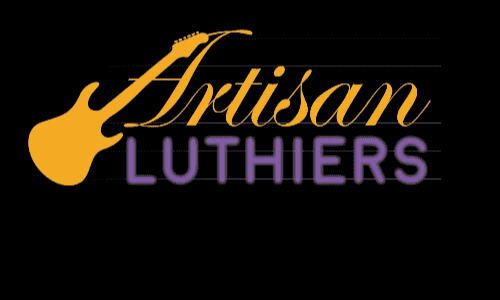
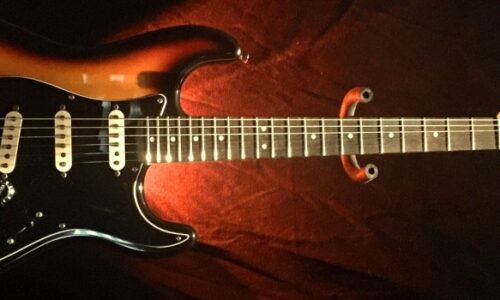
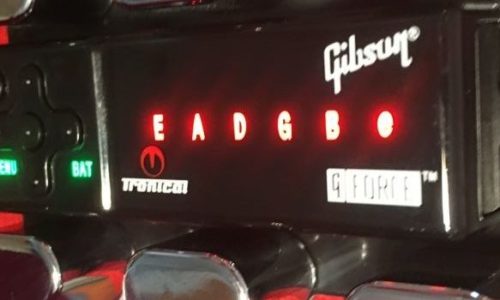
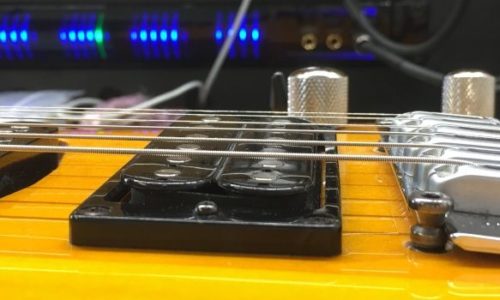
Thank you for sharing excellent information. Your site is very cool. I am impressed by the details that you have on this site. It reveals how nicely you perceive this subject. You, my friend, ROCK! I found just the information I already searched everywhere and simply could not come across. What an ideal site.
A thermal knife is used in applications where a flux-cored soldering station is not feasible. It has a much longer lifespan and does not require the constant cleaning that a cored soldering gun does.
The most common soldering iron watts used in guitar repair is between 25-50 watts. Lower power being 25 watts and used for the more delicate guitar electronics parts like pots, capacitors, and transistors. The higher watts are used to solder heavier duty parts like thick braided wires and guitar cables.
Simply wanna remark on few general things, The website design and style is perfect,
the subject matter is very good :D.
A tool called an ‘instant bond’ is one that can be used as both a soldering station and tool. These products are made by locking two pieces of metal together with heat until a bond forms between the metal. This is a great tool to use because of the fast action that it has.